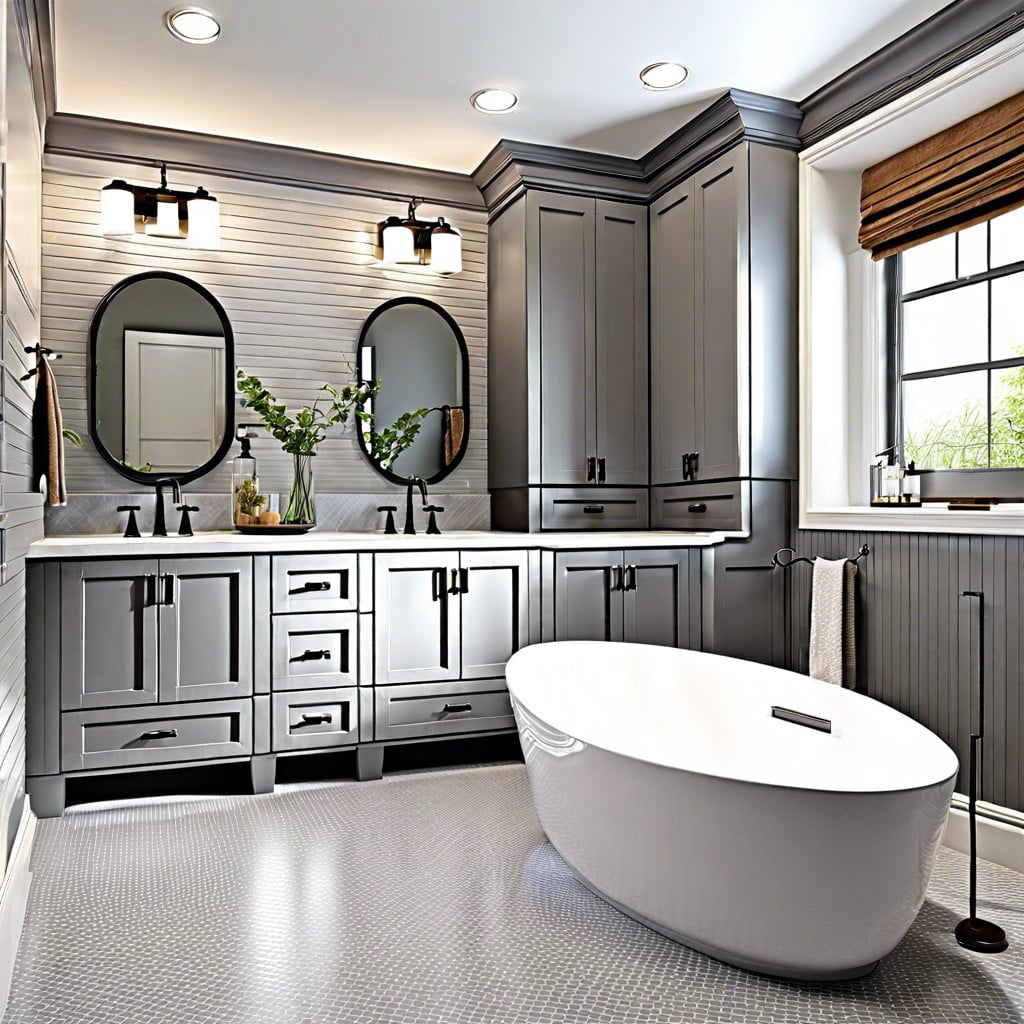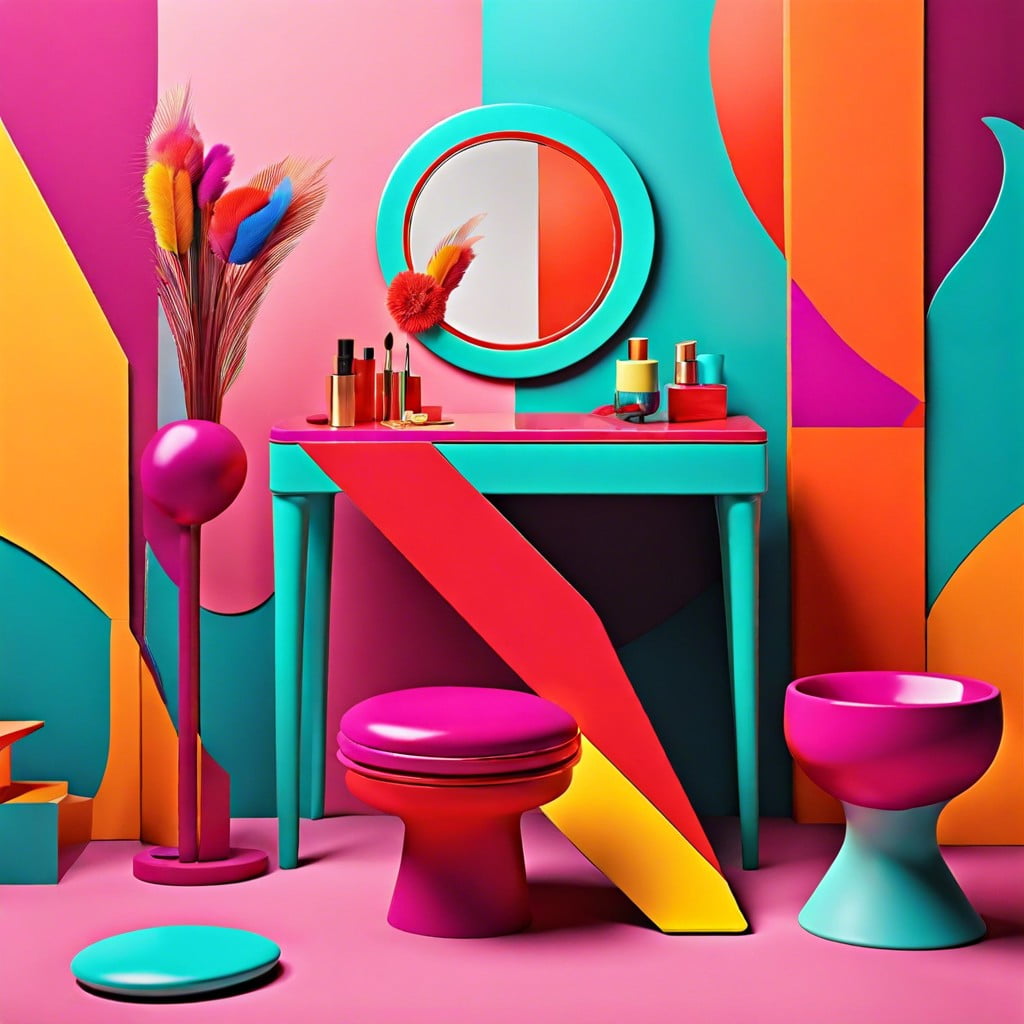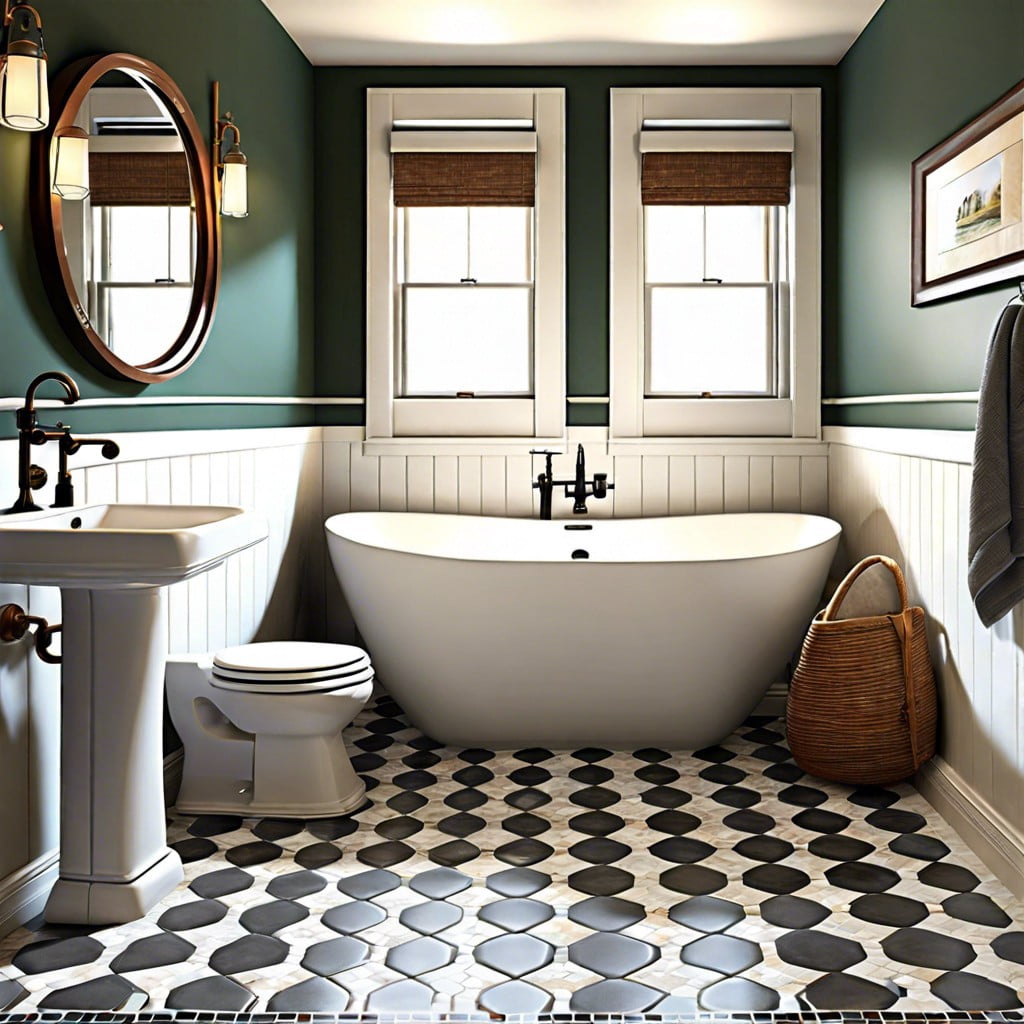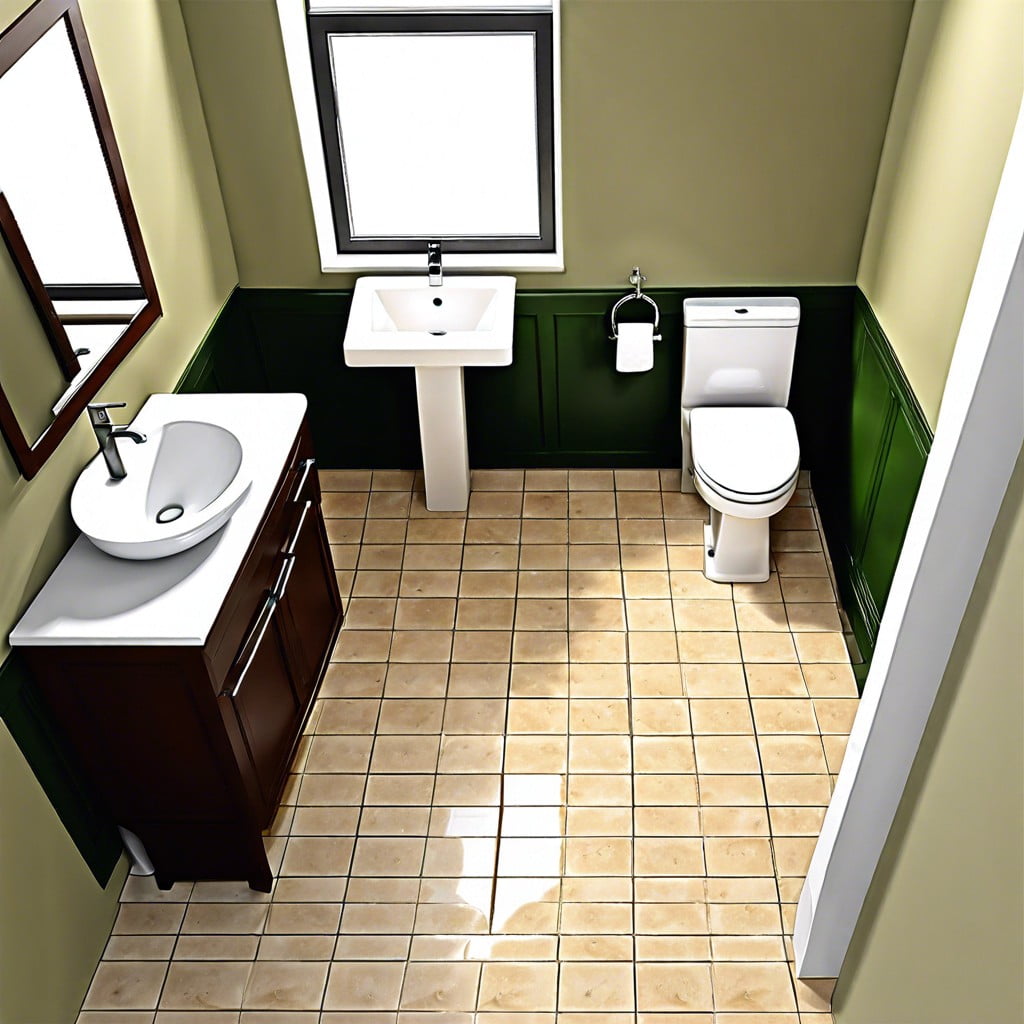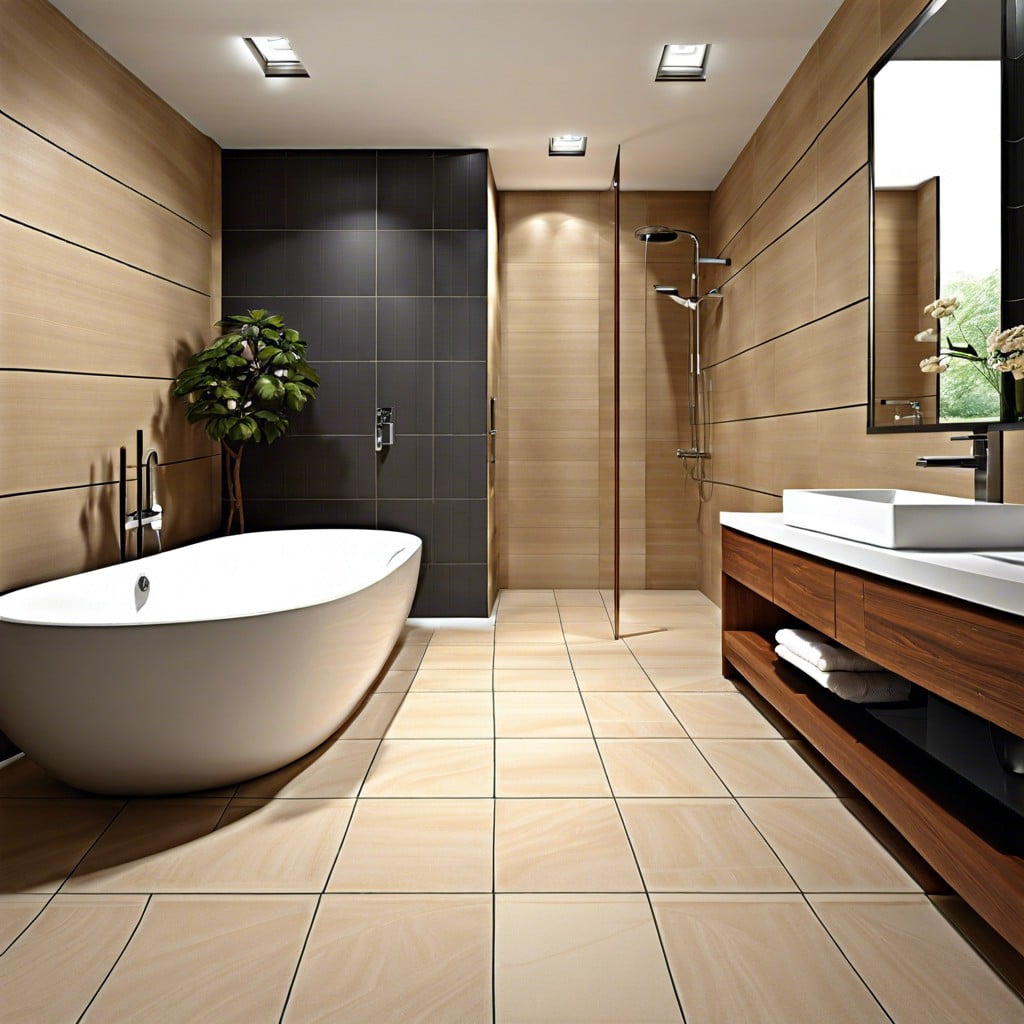Last updated on
Choosing the perfect knobs for your bathroom cabinets can revolutionize your space, because the little details make a big impact.
Key takeaways:
- Knob materials: Metal, glass, crystal, ceramic, wood, and plastic
- Consider shape and size: Proportion, ergonomics, visual appeal, ease of use
- Choose the right finish: Consider existing fixtures, durability, and ease of care
- Match knobs with bathroom decor: Consider color, style, and fixtures
- Installation tips: Gather tools, measure carefully, use a template, drill slowly, check screw length
Understanding Knob Materials
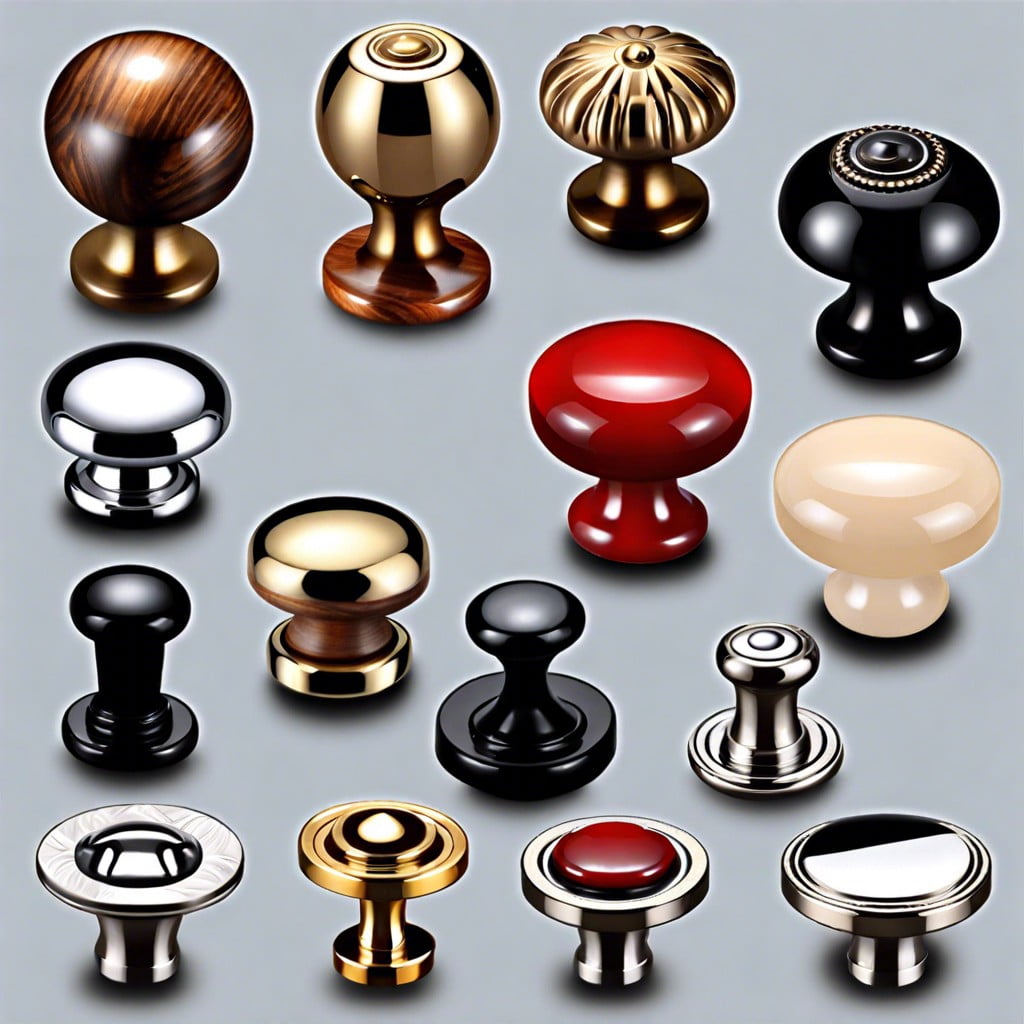
When selecting knobs for bathroom cabinets, material choice plays a pivotal role in both style and durability. Common options include:
- Metal: Brass, bronze, and stainless steel offer a sleek, classic look while resisting corrosion and wear from high moisture.
- Glass: Adds a touch of elegance and can reflect light beautifully, but requires careful handling and regular cleaning to maintain its sparkle.
- Crystal: Similar to glass knobs in their reflective quality but with a more luxurious feel, perfect for a glam bathroom design.
- Ceramic: Provides a wide range of patterns and colors, great for adding a personal touch or a pop of color.
- Wood: Brings warmth and a natural element into the space, best used in well-ventilated bathrooms to prevent moisture damage.
- Plastic: A cost-effective option available in various shapes and colors, though not as durable as other materials.
Each material has unique strengths and potential limitations to consider, such as the maintenance required or how it complements other fixtures and fittings in the bathroom.
Assessing Knob Shapes and Sizes
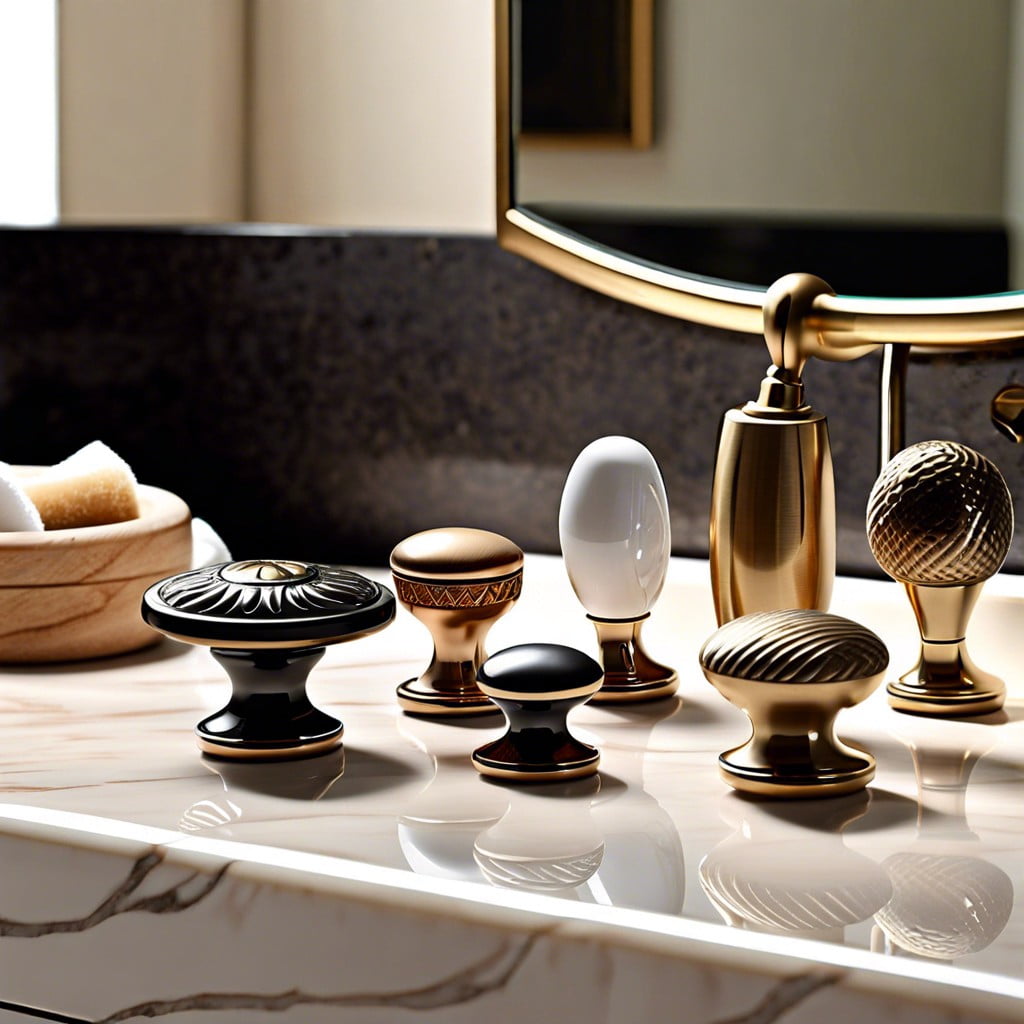
Consider proportion when selecting the size: Larger cabinets often look better with substantial knobs, while smaller ones can be overpowered by knobs that are too big. Conversely, dainty knobs might be lost on expansive surfaces.
Ergonomics play a role in shape choice: Think about how the knob feels in your hand. Rounded edges are usually more comfortable to grip than sharp angles, particularly important in a bathroom setting where hands might be wet.
Visual appeal aligns with shape diversity: From circular and oval to square and T-shape, the contour of a knob contributes to the overall style of the room. Sculptural knobs add character, while streamlined shapes offer a sleek, modern look.
Consider the ease of use for all household members: If you have young children or seniors with limited dexterity in your home, choose knobs that are easy to grasp and operate.
Remember, knobs do not have to be uniform: Mixing and matching sizes or shapes can add visual interest to the bathroom, but ensure a cohesive design to avoid a cluttered look.
Choosing Knob Finishes
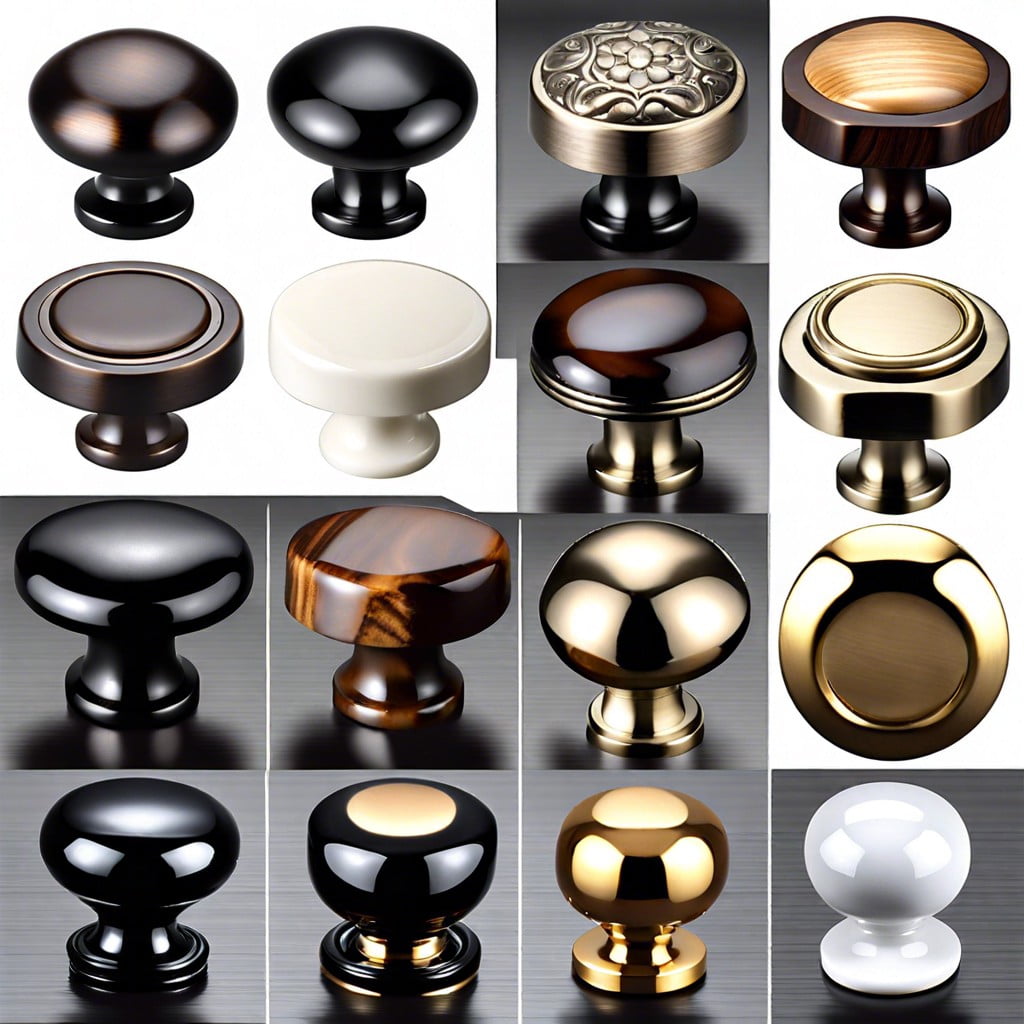
When selecting the right finish, consider the existing fixtures in your bathroom. Chrome and stainless steel offer a modern, sleek look that pairs well with contemporary fittings. Brass or gold finishes add a touch of warmth and luxury, ideal for classic or vintage-inspired spaces.
For a matte texture that resists fingerprints, brushed finishes are practical choices.
Consider the longevity and ease of care for each finish. Some may require more frequent cleaning to maintain their shine, while others develop a patina over time, enhancing their character. It is also important to think about the moisture level in your bathroom; opt for finishes that are less prone to corrosion and rust.
Lastly, experimentation can yield delightful results. Don’t be afraid to mix finishes for a customized, eclectic style that makes your space unique. Just ensure that the final look achieves harmony and balance in your bathroom’s overall design.
Matching Knobs With Bathroom Decor
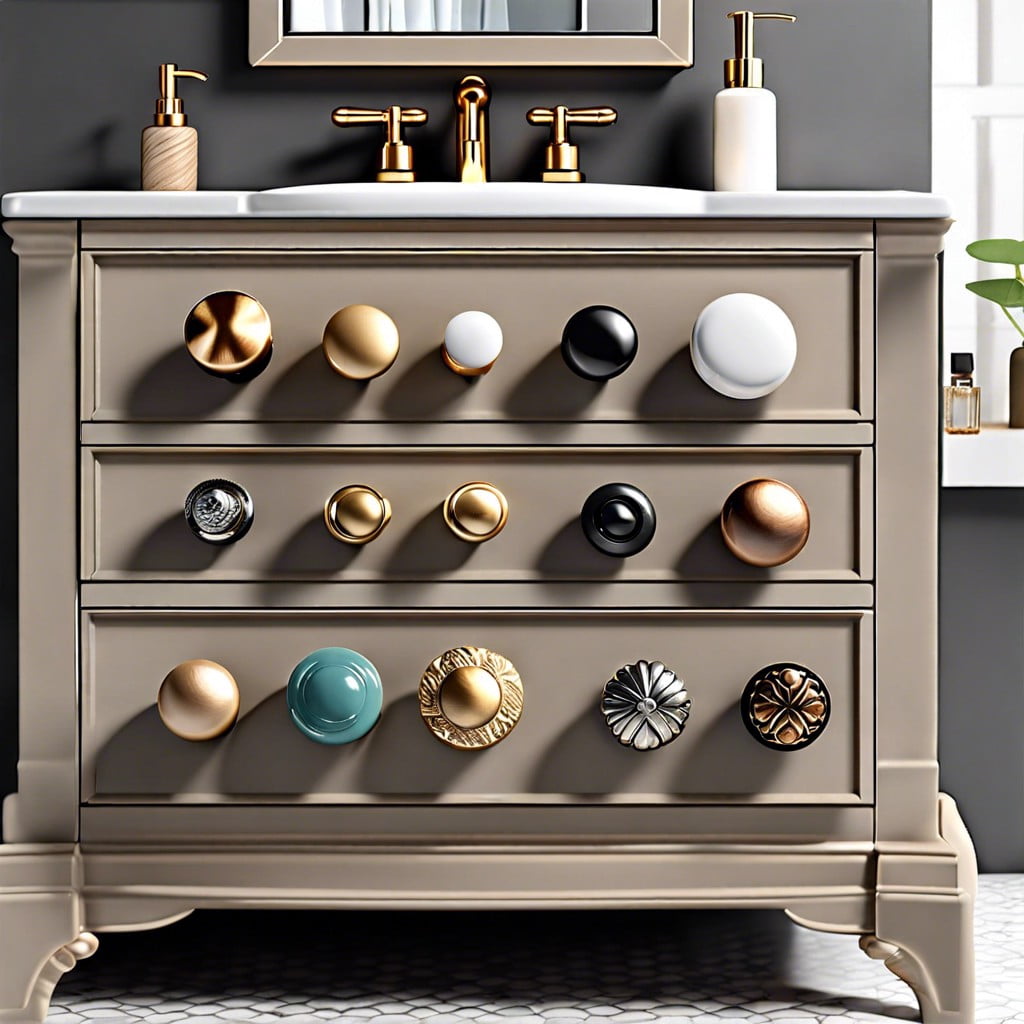
Consider the cabinet color and textures in your bathroom when selecting knobs. A contrasting knob can pop against a cabinet, while a complementary tone will create a harmonious look. For example, dark hardware on light wood can create an alluring visual balance.
Think about the overall style of your bathroom. Sleek, geometric knobs align with modern aesthetics, whereas ornate, vintage-inspired designs may suit traditional spaces better.
Don’t forget about the bathroom fixtures. Knobs that echo the finish of your faucet, shower head, or light fixtures can pull the room together. If your fixtures are brushed nickel, choosing knobs in a similar finish could be a smart move.
Take into account the visual weight of the knobs. Large, bold knobs can be focal points, suitable for spacious bathrooms, while smaller, more subtle knobs might be just right for compact spaces where you don’t want the hardware to overwhelm the room.
Reflect on the atmosphere you aim to create. Knobs with a playful shape or vibrant color can add a touch of whimsy to a family bathroom, whereas spa-like bathrooms may benefit from simple, calming knob designs.
Installation Tips for New Knobs
Begin by gathering the necessary tools: a screwdriver, drill, measuring tape, and a pencil for marking.
Measure the existing holes carefully if replacing old knobs to ensure the new ones fit. If you’re drilling new holes, determine the placement and ensure they’re level and centered on the cabinet door or drawer.
For a template to ensure uniformity, use a piece of cardboard or purchase a cabinet hardware template from a home improvement store.
Drill slowly to prevent wood splintering. If your cabinet’s surface is prone to chipping, apply a piece of painter’s tape over the area before drilling.
Check the length of the screws that come with your new knobs. If they’re too long for your cabinets, you may need to purchase shorter screws or use a hacksaw to trim them to an appropriate length.
Once holes are drilled, attach the knobs by hand first to prevent cross-threading, and then tighten with a screwdriver.
Avoid overtightening, which can damage the wood or distort the knob. A snug fit that allows the knob to sit flush against the cabinet surface is ideal.
If knobs have backplates or additional decorative elements, ensure everything is aligned before the final tightening.
Lastly, open and close the cabinet or drawer several times to test the knob’s functionality and make any minor adjustments if needed.
Maintenance and Cleaning of Cabinet Knobs
Keep bathroom cabinet knobs gleaming with routine care that prevents buildup of soap scum and water spots. For everyday cleaning, a soft cloth dampened with warm water suffices. For deeper grime, a mixture of mild dish soap and water works effectively — just remember to dry knobs thoroughly to avoid watermarks. Avoid using abrasive cleaners which can scratch or dull the finish.
For knobs with intricate designs, use a soft-bristled toothbrush to reach crevices, ensuring all traces of dust and dirt are removed. Metal knobs may benefit from a specific polish, corresponding with the type of metal, to enhance their shine. Implementing these easy practices will ensure that your knobs remain an attractive and hygienic part of your bathroom’s design.
Evaluating Knob Durability and Quality
Inspect the material from which the knobs are made—brass, bronze, glass, and stainless steel offer longevity and withstand frequent use.
Look for solid construction rather than hollow knobs, which tend to be more durable.
Pay attention to the finish; ensure it’s corrosion-resistant, especially important in the high-moisture environment of a bathroom.
Check for warranty or guarantee statements from the manufacturer as an indicator of quality assurance.
Feel the weight of the knob; a heavier knob often suggests a denser material and better quality.
Examine how the knob is affixed to the cabinet; a secure attachment point can be indicative of attention to detail and manufacturing standards.
Consider ease of use, especially for children or those with mobility challenges; a knob that is too small or intricate might be difficult to grip and turn.
Safety Considerations for Bathroom Knobs
Ensuring that bathroom knobs are easy to grasp is crucial, particularly for households with young children or individuals with limited mobility. Opt for designs with smooth edges to prevent clothing from snagging or skin from getting scraped. Additionally, consider non-slip textures for a secure grip, even when hands are wet. It’s also wise to choose knobs made from materials resistant to rust and corrosion for longevity and safety. For a family-friendly environment, think about using knobs that do not contain lead and other harmful materials to mitigate any potential health risks. Remember, the right choice in knobs can make all the difference in creating a safe and accessible bathroom space.
Reviewing Popular Knob Brands and Collections
Not all knobs are created equal. Various brands have carved out niches with distinctive styles and reliable quality. Anthropologie offers artisanal and whimsical designs perfect for a personalized touch, while Home Depot stocks a wide range of knobs fitting for both budget-conscious and luxury-seeking shoppers. Restoration Hardware is a go-to for those with a penchant for vintage and classic aesthetics and Pottery Barn aligns with cozy, traditional themes. For modern, minimalistic designs, consider IKEA’s selection, which is also friendly for those looking for a quick and affordable update. Don’t overlook specialty hardware boutiques; they often carry unique pieces from smaller manufacturers that might just be the perfect statement for your bathroom cabinets.
Environmental Considerations in Knob Selection
When opting for eco-friendly bathroom updates, selecting cabinet knobs becomes an opportunity to make a sustainable choice. Materials like bamboo, recycled glass, or reclaimed metal are not only trendy but also kinder to the planet. These materials reduce the need for new resources and minimize environmental impact.
Consider knobs from companies that prioritize sustainability in their manufacturing processes. Some brands use non-toxic coatings and renewable energy sources during production, which reduces the carbon footprint of their products.
Another point to note is packaging. Select knobs that come with minimal packaging, preferably made from recycled materials. This small step significantly cuts down on waste.
Lastly, investing in high-quality, durable knobs can mean fewer replacements over time, resulting in less waste. A timeless design that outlasts trends will ensure your bathroom remains stylish and sustainable for years to come.
Balancing Aesthetics and Functionality
When choosing knobs for your bathroom cabinets, you’ll want pieces that are not only beautiful but also functional. Aesthetic appeal should complement the practicality; after all, these knobs will be used multiple times a day.
- Look for designs that resonate with your personal style. Whether sleek and modern or vintage and ornate, the knobs should reflect the overall theme of your bathroom.
- Ensure the shape of the knobs provides a comfortable grip. Intricate designs can be eye-catching, but comfort in handling is key to daily use.
- Keep in mind the users of the space. If children or elderly individuals with limited dexterity are using the bathroom, choose knobs that are easy to hold and turn.
- Opt for finishes that can withstand routine exposure to moisture and fingerprints, as some materials and finishes may degrade faster in humid environments.
By carefully analyzing both the look and usability of the knobs, you can create a bathroom space that is cohesive, stylish, and meets the needs of all who use it.
FAQ
Can you mix knobs and pulls on bathroom cabinets?
Absolutely, you can mix knobs and pulls on bathroom cabinets to create a traditional or modern aesthetic, whether with only knobs, only pulls, or a combination of both.
Where do you put the knobs on a bathroom vanity door?
For a bathroom vanity door, knobs should be positioned 2 ½ to 3 inches from the corner of the door, in the bottom corners for upper cabinets and in the upper corners for lower cabinets.
What are the rules for cabinet knobs?
The rules for cabinet knobs suggest placement at 2-1/2" to 3" from the bottom corner of the door for wall cabinets, and the same distance from the upper corner of the door for base cabinets.
Are knobs or pulls more modern?
Pulls are more modern while providing easier access to base cabinets and cabinet drawers, and knobs, while suggesting a vintage style, are useful for reaching upper cabinets.
How to select the right size knobs for bathroom cabinets?
Select the right size knobs for bathroom cabinets by measuring the existing holes or determining the scale of the cabinetry, then choose a knob size that complements the dimensions.
What are the best materials for bathroom cabinet knobs?
Brass, stainless steel, and glass are the best materials for bathroom cabinet knobs due to their durability and resistance to moisture and corrosion.
What’s the impact of knob color on overall bathroom aesthetics?
The knob color in a bathroom significantly influences its overall aesthetics, acting as a subtle accent that can either blend with the architectural style or provide a contrasting pop that defines the space.
Recap
